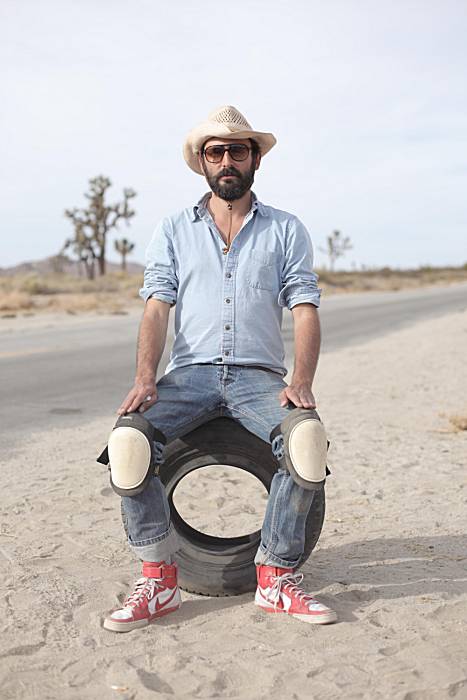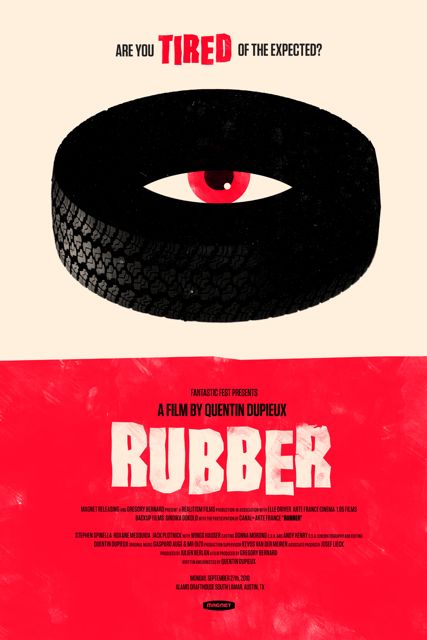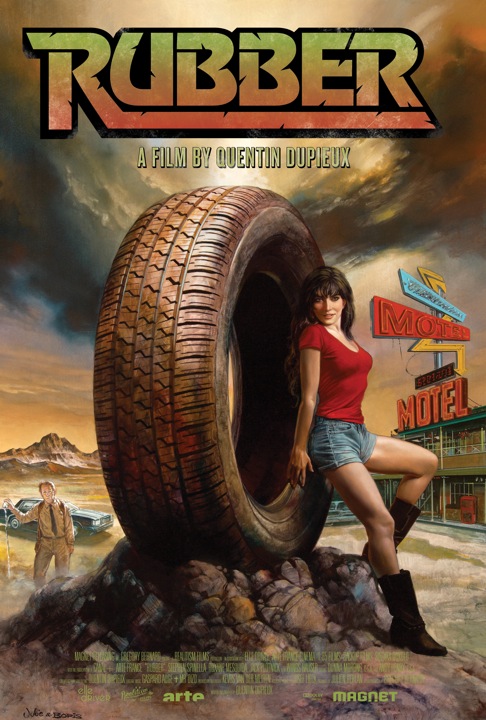Ahoy, squirts! Quint here. This time I have a nice interview with French filmmaker Quentin Dupieux, also known for his music under the stage name name Mr. Oizo, about his crazy fucked up awesome killer tire movie RUBBER. I loved this movie when I saw it at the Fantasia Film Festival and have been singing its praises ever since.
Magnet is pretty ballsy to put this flick out and that they are doing. The film opens this Friday. I have no idea how wide a release it is, but I strongly recommend you seek it out if you like blood, nudity, surrealism and dark, dark comedy.
I quite enjoyed this chat, where we cover how Dupieux brought the tire to life, his inspirations as a filmmaker and his traumatic experience on his previous film. It’s a good one! Enjoy!
Quentin Dupieux: Hi, Eric.
Quint: Hi, how’s it going. man?
Quentin Dupieux: I’m good, thank you.
Quint: I appreciate you taking the time to talk to me a little bit. I got to see the movie at Fantasia Film Festival and I fell in love with it. It was my favorite movie there and I’ve been singing its praises ever since.
Quentin Dupieux: I’m so glad.
Quint: One of the things that I really liked about the film was that you gave the tire an almost Pixar-like origin sequence. We see it learn how to walk and we see it stumble, fall down and get back up. It has a personality and character right off the bat, with no dialogue, which really reminded me of the way Pixar would introduce a non-talking character.
Quentin Dupieux: Yeah, you’re right. When I wrote the movie, for the tire sequence and especially the 20 first minutes, I was thinking about WALL-E because it’s a bit the same. It’s silent and you have to tell a story and you have to describe a character only with actions. I was thinking about WALL-E because what they did in WALL-E, even if it’s a robot… I don’t like the rest of the movie, but the beginning of WALL-E is amazing because suddenly you are feeling the robot; you understand him and you love him already just by observing him.
That’s what I loved about WALL-E and I think I’ve been influenced by that because observing the tire leaving… It’s quite incredible. You just watch him and you learn a few informations about him just by watching, which was really interesting as a challenge like “How am I going to do this? Create life with only a tire and no CGI?” Each one is basically a real tire with no effects.
Quint: The fact that it was real rubber and not a computer effect really helped, I think, in suspending disbelief; following a character, not an effect, as we watch it learn that it has this power to kill, but like a child not really understanding everything.
Quentin Dupieux: Exactly. That’s like the beginning of life, you know. “Oh, I can wake up! Oh, I can roll? I can crush a bottle!” It’s very basic information that was really fun to describe and very interesting as a challenge for a director.
Quint: You give yourself a lot of leeway with the secondary “No Reason” storyline, which I think was actually kind of a really fascinating and very smart thing for you to do because it gives the audience the excuse to just roll with anything that they see.
Quentin Dupieux: Yeah, it was a warning. It was a good way to introduce the movie and to catch the people’s mind. To me it was like a warning, like “Okay, if you don’t like this you should go away!” (Laughs) That was the point. Like if you cut that scene, if you cut the monologue, and if you start directly with the tire coming to life and rolling and falling, it’s not the same movie. It’s suddenly… I don’t know how to say it… It’s quite hard to believe, you know? And that’s the magic of filmmaking, it’s to make people believe.

Quint: I think that that’s the balancing act and I think a lot of the reason why that’s successful is because you pulled off the tire as it is without CGI; as a real thing.
Quentin Dupieux: Yeah, of course. It was really important for me to shoot a real tire, like the real thing. Even if you can create incredible stuff with CGI, it’s almost too perfect, you know? Suddenly with CGI you can do everything, basically, and that’s scary. It’s really funny because since Cannes everybody is asking, “How did you make it? How did you do it? Animation?” Some people think it has been shot frame for frame, like stop-motion and nobody understands!
It’s really simple. It’s like the first steps of movie-making, it’s just a puppeteer off frame operating the tire with his hand. It’s so basic, it’s so simple that people are watching so many incredible stuff, CGI complicated stuff, like TRANSFORMERS, but everybody knows “Okay, TRANSFORMERS is CGI, it’s basically a guy at a computer” and for a thing like a tire rolling suddenly people think it’s incredible, but if you think about it, it’s only a tire rolling and there’s nothing incredible! (Laughs) A tire is supposed to roll around… Do you know what I mean?
Quint: That’s what it’s made for.
Quentin Dupieux: (laughs) Yeah, exactly and suddenly… Since Cannes it’s been amazing, because everybody is asking me like it’s incredible on screen and I say, “Hey look, it’s just a tire rolling…”
Quint: I heard people talk about “I heard that they used a remote control…”
Quentin Dupieux: Yes, well had that, but that’s for let’s say 20 shots in the movie we used a remote control tire, but it was just to do something really simple, because rolling was simple. Obviously you just have to push it and it rolls, but we needed the remote control to make it stop and then roll again, you know, and that’s the only magical effect we had with a remote control tire. It’s rolling, then it stops, then it rolls again.

Quint: That still seems extremely low tech. I think the thing you should really take away from this is that people can’t spot the effect and that’s why there’s a lot of people talking about it. That’s not something you see a lot these days and that’s one of the reasons why I love practical effects so much. Like you said with TRANSFORMERS you watch an amazing robot on robot battle that took three weeks to render in a computer, but everybody knows that’s where it came from.
Quentin Dupieux: Right. We are not impressed any more by all of this because “we know.”
Quint: There’s no awe like seeing the CLOSE ENCOUNTERS spaceship or anything like that. There’s no question in our minds on how they did it.
Quentin Dupieux: Yep, I’m quite happy about that side, because we did the movie with almost nothing you know. Usually, with the budget I had, on a real movie set with that amount of money you can only shoot a guy driving and then parking his car and opening the door and then “cut” you are out of money. (laughs) Really. It was really cheap and I think that’s why there’s probably something cute about it because it’s charming and low budget and low-fi and it contains mental stuff like… Even if it’s cheap and low tech, you believe in it.
Quint: You sell the character.
Quentin Dupieux: To be honest, that was the happiest because working with great actors the text was good and the actors were all very good. It was really easy to work with them because they were happy, they were enjoying the script… But giving life to the tire was the heartbeat, like the first 20 minutes of the movie are with the tire discovering life and that was, even if it was just me with my still camera, it was complicated to create.
Quint: Yeah, well that’s the most important moment. If you don’t hook the audience with it gaining senescence then you’re not going to have them for the rest of the movie. If we can, can we talk a little bit about the Greek Chorus aspect of the movie? That’s something that really kind of took me by surprise when I saw the film. It might just be me reading something into it, but it felt a little bit like a David Lynch-type looking behind the curtain. Where did the origin of having that secondary storyline following the audience watching the story?
Quentin Dupieux: It’s very simple, I just started writing the tire story and after a few pages I realized that only one layer was not enough for me. It was a bit like replacing the shark from JAWS with a tire. It was funny, it was a good idea, but it was just one idea. It’s like “Okay, I’m going to do a murder movie, but it’s not Freddy Krueger, it’s a tire.” Okay, that’s funny, but that’s not enough because we’ve seen all of these movies. We’ve seen CHRISTINE, we’ve seen DUEL by Spielberg…
The challenge was not that exciting to only change the character, so very early in the writing process I decided to add a new layer. I think I had this idea when I saw my first feature. My first feature in France, STEAK, had a huge release in France. We had like 500 theaters, which is really big in France, because I had these two big name French actors. So it was huge, but nobody wanted to see the movie. It was a flop. I snuck into a few theaters to watch and one day I just went to the theater and it was empty and the movie was running for nobody.
Quint: To an empty house?
Quentin Dupieux: Yeah, then I realized “Oh shit!” It’s really sad. A movie needs at least one guy watching to exist because without anybody in the room it’s really sad. It’s like a movie trying to tell a story and nobody is watching… that’s the saddest thing I’ve ever seen! So putting the audience in the movie was a good way for me to talk about that and to have an audience, in a way.
Quint: So you are saying that if you ran into this again and nobody wanted to see this movie, at least you built somebody watching it into the movie! (Laughs)
Quentin Dupieux : Exactly, yeah! (laughs)
Quint: I don’t think there are going to be many empty theaters for this one.
Quentin Dupieux: Thank you. Thank you.
Quint: What are you doing next? Are you moving on to something else film-wise?
Quentin Dupieux: I just moved to LA because I want to shoot another one. I have two new scripts and we are going to decide very soon which one we are going to shoot. It’s a bit like the same economically, like small budget, and that’s why I’m here like I’m going to shoot one or two new movies in this same (way).
Quint: Nice. So, the smaller budget gives you more freedom?
Quentin Dupieux: Obviously yes, because nobody is watching you. With RUBBER I was the only one judging the movie. Usually when you shoot with a crew and with bigger equipment you have at least 20 or 40 people watching you, so it’s a bit like being naked. Everybody is thinking and everybody judges you, everybody has a point of view, and it’s a bit disturbing. You have to explain what you are doing to ten people everyday, which is exhausting and boring and some people can make you doubt, some people judge you… It’s quite complicated and shooting RUBBER was like being alone. I was the only one watching the movie. Because I was shooting with a very small camera, nobody was watching me, so I was free to do anything I wanted. I think I can’t really go back to a big crew and big equipment because I don’t want to be naked again.
Quint: As long as you keep pumping them out like you have been, I’ll be happy. You’ve got a fan in me, that’s for sure.
Quentin Dupieux: (Laughs) Okay!
Quint: Cool, well thank you so much for your time, sir, and I hope you have a good day..
Quentin Dupieux: Thank you.

-Quint
quint@aintitcool.com
Follow Me On Twitter

